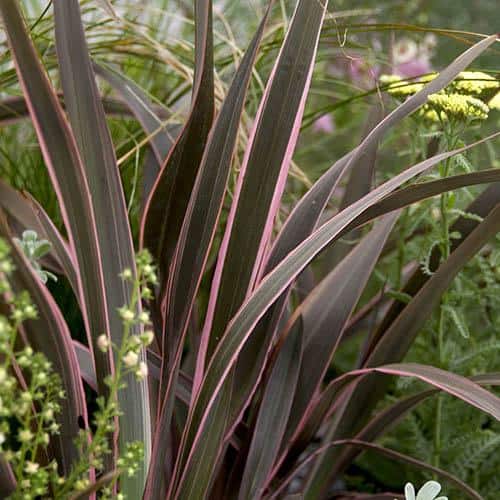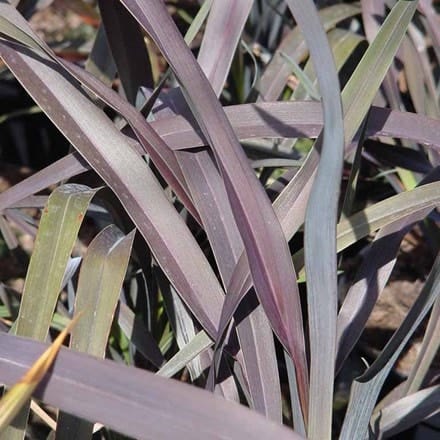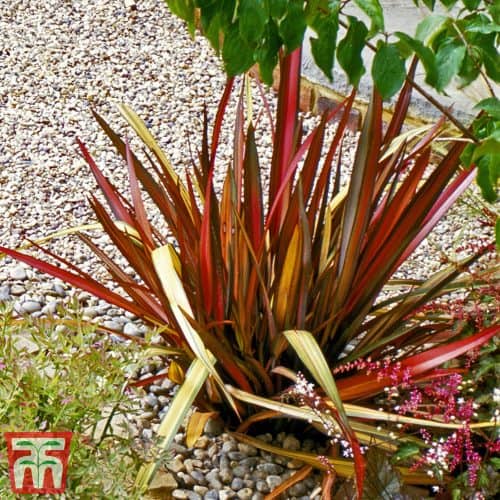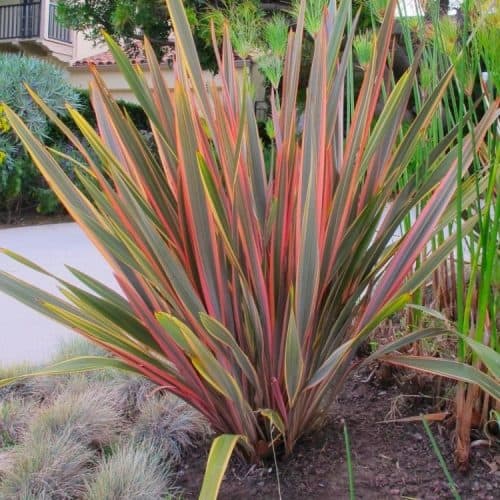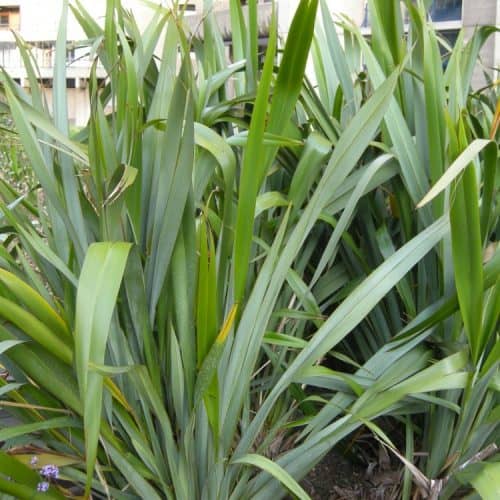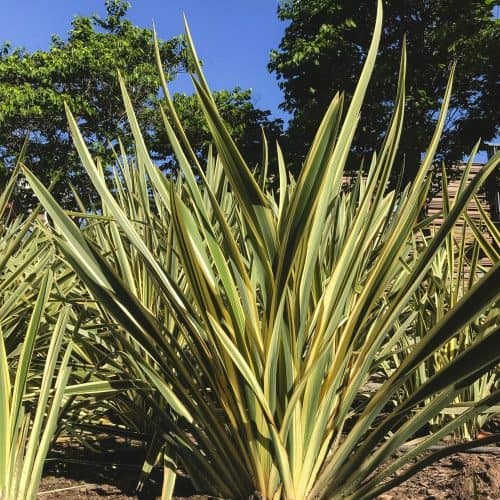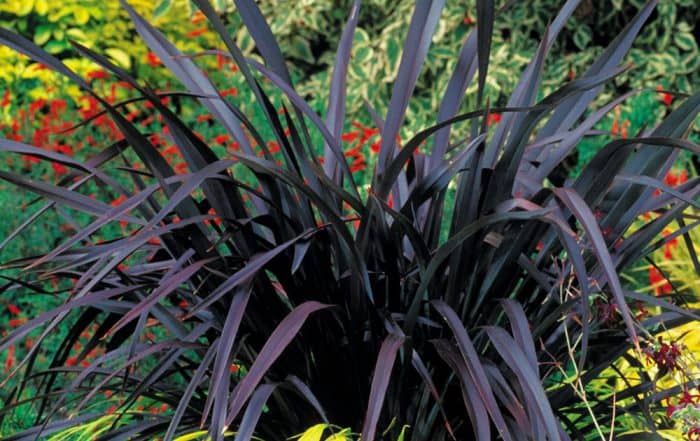Phormium plants are lovely, long-lived evergreen shrubs with striking clumps of elongated sword-shaped leaves. Often colourful foliage is attractive all year and serves as an excellent background for other plants in borders, raised beds, gravel gardens, and pots. The leaf colour ranges from olive-green to purple, yellow, cream, red, and apricot, with wide or fine stripes.

Phormium ‘Black Velvet’
A great tip to maintain a fresh look for your phormiums is to remove dead leaves and flower stems two or three times a year. Simply, pull completely dead leaves firmly to separate them from the plant and prevent a buildup of dead growth. If they won’t easily detach, cut it but leave a short section that can be pulled off later.
Here, we will be discussing the answers to some of the most common questions asked about phormium plants.
IN THIS ARTICLE
Introduction
Phormium plants, also known as New Zealand flax, are sought after for their striking, architectural appearance and low-maintenance requirements. They thrive in various growing conditions and offer a wide range of cultivars, each with distinct colors and growth habits. In this article, we’ll delve into the key aspects of caring for Phormium plants to ensure they remain healthy and vibrant in your garden.
Planting Your Phormium
Choose the right location: Phormium plants prefer full sun to partial shade. In hotter climates, some afternoon shade can be beneficial to prevent leaf scorch. Ensure there is adequate space for the plants to grow, taking into account their mature size.
Prepare the soil
Phormium plants can tolerate a range of soil types, but well-draining soil is essential. They prefer slightly acidic to neutral pH levels. Amend heavy clay soil with organic matter to improve drainage.
Planting
Dig a hole twice as wide as the root ball and slightly deeper. Gently remove the plant from its container and loosen the roots. Place the plant in the hole, ensuring the top of the root ball is level with the soil surface. Backfill the hole with soil, firming it down to remove air pockets. Water thoroughly to settle the soil around the roots.
Watering and Feeding
Watering: Phormium plants are drought-tolerant once established, but they require consistent moisture during their first year. Water regularly, allowing the soil to dry out slightly between watering. In subsequent years, reduce watering frequency, especially during cooler months.
Fertilising: Apply a balanced, slow-release fertiliser in spring to encourage healthy growth. Avoid excessive nitrogen, as it can result in overly lush foliage that detracts from the plant’s architectural form.
Pruning and Maintenance
Pruning: Regularly remove any dead or damaged leaves to maintain the plant’s appearance. Major pruning is typically not necessary but can be done in late winter or early spring if desired. Cut back any damaged or old leaves close to the base of the plant.
Cleaning: Wipe down the leaves occasionally with a damp cloth to remove dust and debris, which can hinder photosynthesis.
Pest and Disease Control: Phormium plants are relatively pest and disease-resistant. However, watch for common issues such as aphids, mealybugs, or fungal diseases. Treat any infestations or diseases promptly with the appropriate pesticide or fungicide, following label instructions.
Propagation
Phormium plants can be propagated by division or from seed.
Division: Divide mature plants in early spring or late summer. Carefully dig up the plant, keeping the root ball intact. Use a sharp, clean knife or spade to divide the plant into smaller sections, each with a healthy root system and foliage. Replant the divisions immediately, watering them thoroughly.
Seed: Collect seeds from ripe seed pods in late summer or early autumn. Sow seeds in a well-draining seed compost, maintaining a temperature of around 60-65°F (15-18°C). Germination can take several weeks. Once seedlings are large enough to handle, transplant them into individual pots and grow them on until they are ready to be planted out in the garden.
Conclusion
Caring for Phormium plants is relatively straightforward, making them a popular choice for gardeners seeking low-maintenance, architectural plants. By following the tips outlined in this article, you can ensure your Phormium plants remain healthy and vibrant, creating a stunning focal point or structural element in your garden.
More: Are Phormiums frost hardy?
Do Phormiums flower every year?
Phormium plants produce beautiful flower spikes annually between spring and summer. If your flax plant is not producing flowers, it might be because of the growing conditions, specifically the positioning. Too much shade might hinder flower blooms. Also, if your plant is less than 5 years old, it will likely not produce flowers.
Does Phormium grow in shade?
Phormium can grow in either the sun or the shade, can withstand coastal sprays and winter frosts, and has a moderate thirst for water. They are generally greedy plants that will grow rapidly if they are well fed. They are happy to be placed in an exposed location and make an excellent introduction to a coastal garden. They can withstand both full sun and partial shade.
Can I cut back phormium / flax?
Yes, you can cut back your flax plant for aesthetic purposes; either cut it back to the ground for a more formal look or let the spent flowers die back for a more casual look. You can also cut your phormium plants back to prepare them for winter.
Most flax varieties are frost resistant, however, if they have been damaged by frost, wait until the risk of frost has passed before removing the burned outer leaves as this will encourage better growth in spring. Read more about this: Can phormium be cut back?
How Can I Prune a Flax Plant?
Pruning a flax plant is very easy once you are conscious of the best practices. The best pruning period is autumn when the growing season is almost over. You can prune to keep your flax tidy, or divide them and encourage fresh growth of leaves.
To prune your phormium plants, use a sharp knife to cut out old, browning, or damaged foliage. The dead leaves cut off when pruning in autumn should be left around the base of the plant to form a layer of mulch that can protect the roots from bouts of frost that can easily hurt your flax plant.
Other types of Phormium we cover:
Phormium Black Adder, Black Velvet, Bronze Baby, Colensoi, Cookianum, Evening Glow, Golden Ray, Jester, Maori Queen, Pink Stripe, Platts Black, Rainbow Queen / Maiden, Phormium Sundowner, Phormium Tenax, Phormium Tenax Variegatum, Yellow Wave.
Further reading:
- Are Phormiums Hardy Plants in UK Gardens?
- Grow Guide: How to look after Phormium Plants
- Cutting Back: Can Phormiums be pruned or cut back?




